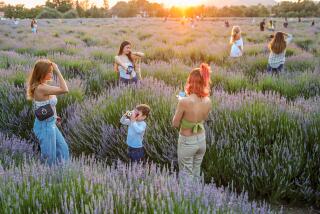GARDENING : Lavender’s Versatility Is Something Special to Savor
- Share via
Mention lavender, and most of us immediately think of a color. But gardeners and floral crafters around the world also identify lavender as a popular plant.
As you’d expect from its name, lavender typically has light or dark blue-violet flowers, although some gardeners also cultivate rarer pink-and white-flowered varieties. Garden centers often describe lavender as a shrub since it grows 12- to 30-inches tall and has a number of branches topped with spikes of flowers and greenish-gray leaves.
Although lavender has long been popular both fresh and dried, many gardeners and crafters prize lavender for its delightful and long-lasting fragrance. In past generations, lavender held several symbolic meanings. In the Victorian era, for example, lavender signified loyalty and devotion. In other times, it indicated distrust.
English lavender, the most common variety in the United States, works well in both herb gardens and flower beds. You’ll see it planted as a low hedge, in the middle to front of a perennial garden and in rock gardens. Because it tolerates light and heat reflected from paving, many homeowners use it for edging walks and driveways.
Lavender prefers full sun and moist, well-drained soil fortified with organic matter. Prune off about half of the top after the plant blooms or just before growth begins in the spring. Potted lavender placed in a cool room with a southern exposure can survive indoors.
To use fresh lavender, pick it when about half the flowers on the spike are open. If you want to dry the lavender and use the entire dried spike, pick the spikes when the flowers have just begun to open. However, if you plan to remove the dried lavender flowers from the stems, pick spikes that are nearly in full bloom.
To air-dry, hang bunches of spikes or lay individual spikes or flowers flat. Either way, lavender normally dries in about two weeks. If you plan to use just the dried flowers, remove them from the stem by holding the spike over a bowl and gently rubbing between your hands. Store the loose lavender flowers in an airtight jar.
Lavender rates high in versatility, and even finds its way into recipes, cosmetics and mild sedatives. For floral crafts, it’s especially well-suited. The flower spikes add color and fragrance to arrangements and wreaths, and loose lavender becomes a fragrant and colorful addition to potpourris, sachets and wands.






